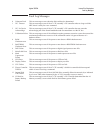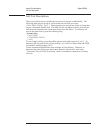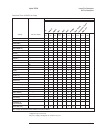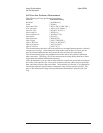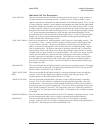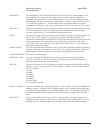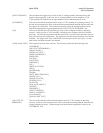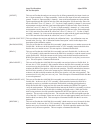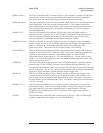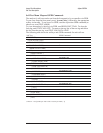
[ SERIAL PORT ] This test verifies that the RS-232 interface on the A7 CPU assembly is capable of sending and
receiving data. In this test, the user connects the transmit data line to the recieve data line.
Data is sent out on the transmit data line and read back on the receive data line.
[ SEEK RECORD ] This test verifies that the A100 Disk Drive assembly’s head can move to a user specified record
on the flexible disk. In this test, the disk controller on the A7 CPU assembly instructs the
disk-drive head to move to a user specified record. The user specified record number must be
in the range of valid record numbers. The default record number is 0. This test requires a
formatted flexible disk.
[ SOURCE LO ] This test verifies that the local oscillator (LO) gate array on the A6 Digital assembly is
operating correctly. In this test, the A7 CPU assembly’s microprocessor configures the LO
gate array and reads its control lines to check circuits internal to the gate array and verify
correct configuration. No data paths on the Digital assembly are checked.
[ SOURCE TO CPU ] This test verifies that the core of the digital source on the A6 Digital assembly is operating
correctly. In this test, the A7 CPU assembly’s microprocessor configures the digital source to
output a 12.8 kHz chirp. The microprocessor then reads the final chirp value in the
digital-source RAM. This test does not use the time record to verify the chirp.
[ TACHOMETR ] This test verifies that the tachometer circuits on the A10 Rear Panel assembly and A6 Digital
assembly are operating correctly. In this test, a BNC cable must be connected from the source
connector to the tachometer connector. The tachometer pulses are counted for 200
milliseconds with the source turned off. The count should be zero. Next the source is set to
100 Hz, 3.53 Vrms and the tachometer pulses are counted for another 200 milliseconds. This
time the count should be 20 ±1.
[ TRIGGER ] This test verifies that the trigger gate array on the A6 Digital assembly is operating correctly.
In this test, the A7 CPU assembly’s microprocessor configures the trigger gate array. The
microprocessor then reads the control lines to check circuits internal to the gate array and verify
correct configuration. This test also verifies functions internal to the gate array such as internal
trigger level, trigger interrupts, overload interrupts, and post trigger delay.
[ WITH LO ] This test verifies the capability of the A5 Analog assembly’s analog source to output a flat
zoomed periodic chirp signal. In this test, the A6 Digital assembly’s local oscillator is used
with the analog source to produce a zoomed periodic chirp signal. The signal is connected to
the input channels via the calibration path (CALP). The flatness of the signal is measured from
13.6 kHz to 26.4 kHz.
[ WITHOUT LO ] This test verifies the capability of the A5 Analog assembly’s analog source to output a flat
baseband chirp signal. In this test, the Analog assembly’s analog source outputs a baseband
chirp signal (starting at 0 Hz) that is connected to the A1 Input assembly or A2 Input
assemblies via the calibration path (CALP). The flatness of the signal is measured from
384 Hz to 51.2 kHz.
[ ZOOM ] This test checks most of the DSP chain, including the LO gate array. In this test, the Digital
assembly’s trigger gate array outputs a dc value to the DSP chain.
Agilent 35670A Internal Test Descriptions
Self-Test Descriptions
10-17



